.
What Fuels Fashion? 2025
The second edition of What Fuels Fashion? ranks 200 of the world’s largest fashion brands on disclosure of their climate and energy-related policies, practices and impacts in their own operations & supply chains.
Brands are scored on how transparent they are across five critical areas:
- Accountability
- Decarbonisation
- Energy Procurement
- Financing Decarbonisation
- Just Transition & Advocacy
What’s new for 2025?
This year, we’ve raised the bar. Our scope now covers 200 billion-dollar brands with a turnover above $1 billion, worth a combined $2.7 trillion. These billion-dollar brands are the most powerful players determining fashion’s climate future.
We’ve also introduced tougher indicators to uncover whether brands are disclosing credible plans to phase out coal, electrify factories with clean heat technologies like heat pumps and electric boilers, and protect workers from dangerous heat stress.
Clean Heat: Fashion’s Climate Test
Fashion’s biggest and most solvable climate challenge is heat. Fossil-fuelled boilers still dominate dyehouses, laundries and finishing mills where the fabrics behind our clothes are made — the single largest source of supply chain emissions. Clean alternatives already exist, yet most brands are failing to act.
What Fuels Fashion? 2025 takes a temperature check of these Big Fashion giants — exposing how little the industry discloses about credible plans to phase out coal, electrify factories, and scale renewable energy, and which are withholding this data altogether.
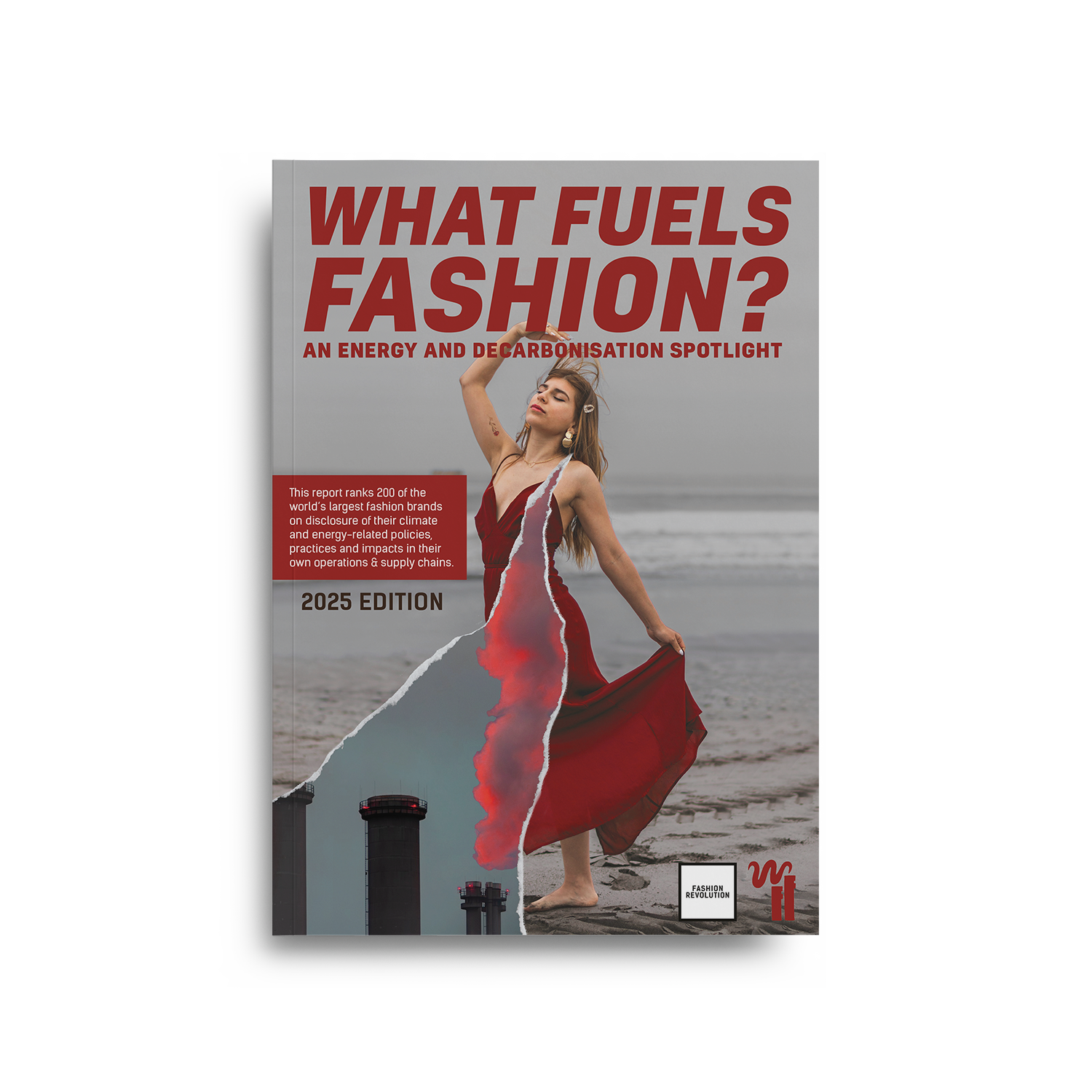
KEY FINDINGS
The fashion industry is a key driver of the climate crisis. Instead of cutting emissions at the pace science demands, Big Fashion is dragging its feet while its demand for fossil fuels keeps climbing. From farming fibres to finishing fabrics, coal, gas, and biomass power almost every stage of production — fuelling toxic emissions, unsafe heat for workers, and accelerating environmental breakdown.
The single biggest opportunity for change lies in clean heat: renewable, fossil-free energy for manufacturing. Unlike heavy industry, fashion faces relatively low barriers to electrification. Proven solutions like heat pumps and electric boilers are already available to replace fossil-fuelled boilers in supply chains.
Key findings include:

OVERALL SCORE
Transparency remains alarmingly low — evidence that the industry is still dragging its heels while emissions rise. The average brand score is just 14%, showing how few brands disclose credible plans to phase out coal, electrify factories, or scale renewable energy.

Fashion is Failing to Act On Its Most Urgent Opportunity: Clean Heat
Only 10% of brands disclose supply chain renewable electricity targets and an even fewer 6% disclose broader renewable energy targets. This leaves most brands without a public roadmap to power their supply chains with clean energy – impacting credibility and questioning industry’s intent to change.
A mere 6% disclose any efforts to electrify high-heat processes — despite proven solutions like heat pumps and electric boilers commercially available.

Brands’ Coal Phase-out Targets Stop Short
Fashion’s climate targets are falling dangerously out of step with reality. Less than a quarter of big fashion brands (at 18%) disclose coal phase-out targets in their material processing.
No brands’ coal phase-out is as ambitious enough to include purchased steam. If purchased steam isn’t included, brands’ phase-out targets stop short, leaving a major loophole. Including purchased steam in a target means that all coal-derived heat in production – not just what is burned on their own premises – is covered.
This exclusion keeps fashion locked into fossil fuels when it has the potential to help transform entire industrial zones. When multiple brands demand action, it creates leverage for cleaner infrastructure that lifts the floor across industries and accelerates decarbonisation far beyond fashion alone.

Show us the Money
Brands set ambitious supply chain decarbonisation targets, but most fail to show how they support suppliers to deliver them, making financing the transition a guessing game. Just 6% disclose how much upfront investment support has been provided to suppliers for decarbonisation, for example to replace coal-powered boilers with electric ones or heat pumps. Fewer (2%) disclose supporting suppliers with ongoing costs of running new technologies like increased electricity bills or equipment maintenance.
Expecting suppliers on razor-thin margins to bankroll million-dollar transitions is unrealistic. Without brand-led financing and genuine partnership, supply chain decarbonisation will stall.

The Chicken-And-Egg Problem
Suppliers can’t risk investing in costly clean tech while grids still run on fossil fuels — and governments won’t expand renewables without clear demand. The cycle goes on.
Brands sit right at the centre of this deadlock. Yet most are failing to use their financial or political power to break it.
Only 7% of brands show evidence of advocating for renewable energy in garment-producing countries, and just 6% disclose direct investment in grid-scale renewables.
With their influence, brands have both a duty and an opportunity to shape the future — by championing supportive policies and investing in real structural change.

Accounting, Not Accountability
When it comes to energy procurement, 60% of brands disclose how they are accounting for energy sourcing in their own operations – but when it comes to their supply chains, things are less clear.
Just 11% disclose how renewable energy is accounted for in supply chains and many lean on Renewable Energy Credits (RECs), which mask fossil fuel use. This makes climate action for many brands an exercise in accounting, not accountability.
True decarbonisation means powering supply chains with real-time renewable energy every hour of the day. But with no brand disclosing this approach, the industry is lagging behind.

Advocacy Gap
Fashion demands suppliers decarbonise, yet most brands do little to help them succeed.
Brands must advocate for structural change to decarbonise successfully. Only 7% of brands disclose evidence of political advocacy activities in garment-producing countries, and just 2% report their outcomes.
Additionally, evidence of brands financing renewable energy projects is lacking across the board, despite it being in their best interests to support it.
Brands are missing opportunities for direct climate action – instead forcing supply chains to cover the costs of industry change.

Traceability Blackout
Publicly-listed fashion brands, despite being answerable to shareholders, make up a surprising 59% of brands scoring zero on traceability – failing at the most basic level of transparency and exposing a glaring accountability gap in ESG oversight.
Supplier visibility is vital. A lack of traceability makes it impossible to evaluate climate risks or to channel finance into credible decarbonisation, making it a direct block to climate action.

Climate Risks Undisclosed
The climate crisis is already disrupting fashion supply chains, from floods to droughts and escalating heatwaves, yet little more than half of brands (57%) provide details of these climate-related risks.
To prepare for the future, brands and retailers must understand how these risks impact not just their ability to operate, but the health and safety of their garment workers. Without visibility, brands are failing in their due diligence.
Understanding climate risks is essential to robust strategies — not only to cut emissions, but to build resilient supply chains able to withstand escalating shocks.

Fashion Still Chooses Profit Over Climate
CEO pay is rising, but climate accountability isn’t. Only 15% of brands link executive bonuses to absolute emissions cuts and most tie just 10% of bonuses to climate. Just 20% of brands disclose supplier incentives. And with only 7% disclosing an internal carbon price, fashion is lagging far behind other sectors in embedding climate accountability into financial decision-making.

Emissions Reduction and Partnership — Missing in Action for the Majority.
Climate progress is stalling — and brands’ failure to work with suppliers is a major reason why.
Just 55% of brands have SBTi-verified targets, but fewer than 29% show evidence of actually cutting emissions.
Only 20% are transparent about consulting suppliers on climate targets, and a mere 9% co-create adaptation plans.
Genuine collaboration would strengthen decarbonisation, build resilience to climate shocks, and make supply chains stronger. But too few brands are taking this approach.

Ownership Matters in Decarbonisation
Brands that own their supply chains are more stable, therefore better placed to invest in renewable energy, test new clean heat technologies and prepare production for climate change.
Yet just a quarter of brands at the manufacturing level and 19% at the processing level disclose that they own their supply chains. Even more telling is that among these, levels of ownership are minimal: more than half report owning no manufacturing or processing facilities.
Big fashion needs to turn away from shaky, short-term contracts and opaqueness in their supply chain, to play their part in driving successful decarbonisation and on broader climate goals.
WITH WORKERS ON THE FRONTLINES, BIG FASHION NEEDS A TEMPERATURE CHECK
Even as extreme temperatures leave garment workers fainting, falling ill and losing income as productivity drops, it is still not a requirement for suppliers to publicly disclose factory data on heat and humidity levels, (otherwise known as Wet Bulb Globe Temperature, or WBGT), with 0% of brands disclosing this data.
Making it mandatory for factories to disclose this data would give power to workers to bargain for protections. It would also provide investors with accurate information to better assess a brand’s financial and operational risks.
Brands could leverage this data to inform adaptation costs such as implementing cooling systems. It could also inform adaptation tools, like insurance that trigger automatic pay-outs when dangerous heat thresholds are met and it is unsafe for workers.
A temperature check is only the first step — the next is turning data into power, protection, and payouts for workers.
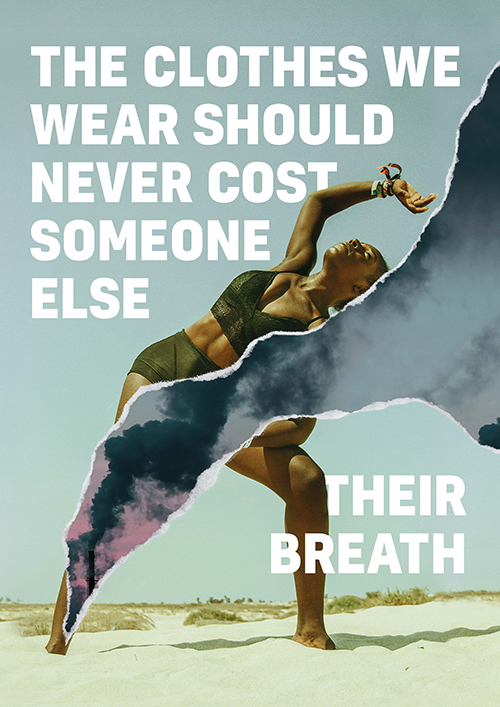
CLEAN HEAT FOR COOL WORK
We’ve worked with climate campaigning organisation Action Speaks Louder to build a framework for industry adoption. ‘Clean Heat for Cool Work’ proposes tackling fossil-fuelled heat on two fronts, combining low-cost monitoring with high-investment solutions. As a dual mitigation and adaptation-linked framework, it calls for:
- Swapping fossil boilers for clean tech. Replacing coal, gas, and biomass boilers with electric alternatives like industrial heat pumps to cut emissions while also helping to protect workers from heat stress and reduce air pollution in the workplace and surrounding communities.
- Tracking heat data and worker-led due diligence. Worker-led continuous monitoring and public disclosure of factory heat and humidity data (WBGTs).
This two-track approach of low-cost monitoring of heat and humidity levels paired with high-investment solutions helps to inform adaptation costs (e.g. cooling systems), gives investors a decision-useful metric to assess risks, enable tools like parametric insurance, and establishes a baseline to measure adaptation improvements from electrification (like cooler workplaces and clearer air).
See the report for a full list of recommendations for brands, investors, and policymakers.
TAKE ACTION

SUBSCRIBE TO OUR NEWSLETTER
Sign up to the Fashion Revolution newsletter for campaign updates and more ways to take action
SUBSCRIBE
USE THIS RESEARCH
Inform your activism, not your consumption. Scrutinise brands and hold them to account.
.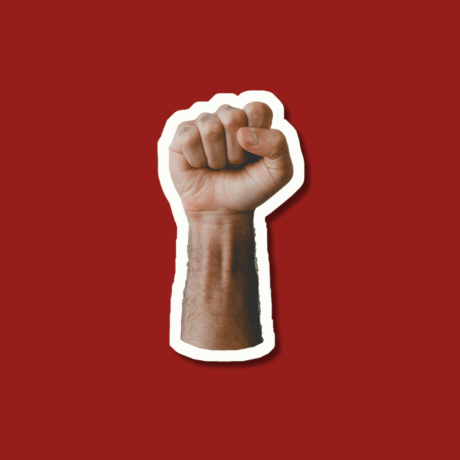
DEMAND WORKER PROTECTION
Push brands to disclose data on factory heat and humidity levels (WBGT) and address unsafe heat facing the people who make our clothes.
.WHY ARE WE FOCUSING ON CLEAN HEAT?
Instead of cutting emissions at the pace science demands, billion-dollar fashion brands are dragging their feet – withholding even the most basic data while emissions continue to soar.
Many brands also lean on Renewable Energy Credits (RECs) which mask fossil fuel use, making climate action for many brands an exercise in accounting, not accountability.
True decarbonisation means powering supply chains with real-time renewable energy — and this lack of transparency means a lack of accountability, and a lag in climate progress.
Clean heat is the single biggest lever for cutting supply chain emissions and real-world solutions already exist for supply chains to implement.
Through ditching fossil fuels and adopting climate-first solutions – like heat pumps and electric boilers – brands have the power to drive the decarbonisation of the fashion industry, before the window of opportunity closes.
Safe working conditions are a human right. As global temperatures rise inside and outside of the factory, heat stress is rising too. Making heat and humidity data recording a must for fashion supply chains is the first step in protecting workers from exposure to polluted and overheated conditions.
A temperature check is only the first step. The next is turning data into power, protection, and payouts for workers.
Suppliers hesitate to dump coal for electricity while government utilities hold back from powering grids with renewables – but electrification now still saves energy and cuts emissions.
As grids get cleaner, the benefits only grow. Collaboration and grid advocacy is essential, as brands can collectively drive industry change – but we’re not seeing it.



“The path to decarbonisation will be won or lost by how fashion tackles heat. Industrial electrification is a Just Transition opportunity that must centre workers and suppliers. If fashion fails to act, it jeopardises its integrity in a world moving beyond fossil fuels — and with it, the health, safety, and dignity of the people who make our clothes.”
Liv Simpliciano, Head of Policy & Research at Fashion Revolution.
“Fashion brands love to promote innovative new products, but the Victorian-era reality of burning coal and wood to manufacture these products is quietly swept under the rug. As access to renewable energy and clean heat technologies grows globally, fashion brands have the responsibility to address their dependence on toxic fuels and safeguard the wellbeing of workers and communities.”
Ruth MacGilp, Fashion Campaign Manager, Action Speaks Louder
“The textiles industry can lead by example: because process heat rarely exceeds 250°C, it has the potential to move entirely away from fossil fuels. The possibility is here — now companies must commit and set clear strategies to enable the transition.”
Jan Rosenow, Professor of Energy and Climate Policy at Oxford University
FAQs
‘What Fuels Fashion?’ is research that Fashion Revolution has developed to spotlight major fashion brands and retailers’ progress on decarbonisation. To drive the changes we urgently need, greater transparency, reliable data and increased advocacy are crucial to push big fashion brands toward more sustainable manufacturing processes.
It is an advocacy tool to drive positive change through wider public awareness-raising and education, lobbying governments, championing small and responsible designers and building a network of activists around the world united by an urgent call to action.
By focusing on a single-issue, Fashion Revolution is placing significant spotlight and media attention solely on decarbonisation and major fashion brands’ performance on it, thus increasing the pressure on brands and therefore the potential for impact.
‘What Fuels Fashion?’ reviews brands’ public disclosure on climate and energy-related data in their own operations but primarily in their supply chains.
The research is broken down into five key themes, including:
- Accountability,
- Decarbonisation,
- Energy Procurement,
- Financing Decarbonisation
- Just Transition and Advocacy
Brands receive points for information that has been publicly disclosed on the brand or parent company website, through self-published annual reports and via third parties where there is a link between the company’s website and the third-party disclosure.
The methodology for the ‘What Fuels Fashion?’ report differs significantly from that of the Global Fashion Transparency Index. It places a strong emphasis on climate and energy-related data, focusing on brands’ own operations and, primarily, their supply chains. Unlike previous reports that assessed the transparency of brands’ policies and commitments across various topics, this report zeroes in on assessing big fashion’s transparency and efforts in reducing carbon emissions, sourcing renewable energy, investing in decarbonisation, and supporting and advocating for just, clean and fair energy transitions for workers and communities.
Transparency is essential for mitigating the worst impacts of the climate crisis; we can only manage what we can measure. Primary data is crucial for assessing the scale of the problem and designing effective plans to address fashion’s impact. While transparency is the bare minimum we should expect, it plays a critical role in holding brands accountable for their human rights and environmental impacts across their supply chains.
We understand that citizens are seeking rankings of the ethics and sustainability of major fashion brands. But this is not the intended purpose of ‘What Fuels Fashion?’.
‘What Fuels Fashion?’ is shining a spotlight on how much information big fashion shares about their climate efforts. Transparency is a necessary first step for holding them to account for their impacts.
Transparency underpins sustainability – without transparency, achieving a sustainable, accountable and fair fashion industry will be impossible.
Being ranked highly in this research means a major brand is comparatively more transparent than other big brands. We are not making any statement about whether a brand is ethical or sustainable.
‘What Fuels Fashion?’ is designed as an index to facilitate comparisons of major brands’ and retailers’ public disclosures on their decarbonisation efforts. This format allows brands to easily assess their performance against peers and competitors.
From our experience, ranking brands is a highly effective tool in incentivising transparency and pushes them to progressively improve public disclosure of social and environmental information.
‘What Fuels Fashion?’ draws on the same scope of brands reviewed in the Global Fashion Transparency Index. It reviews and ranks 200 of the world’s largest and most influential fashion brands and retailers.
As the biggest and most powerful consumer brands in the apparel industry, the brands reviewed in this research have the most significant negative human rights and environmental impacts and the greatest responsibility to change. Where brands are privately held, we have made an educated guess regarding their size and turnover. Geographic spread is considered too.
No, brands and retailers don’t pay and cannot choose to be included in ‘What Fuels Fashion?’.
We decide which major fashion brands and retailers are reviewed based on their annual turnover, aiming to target the world’s largest companies. We review brands whether or not they participate in the process by completing our questionnaire and they are given points based entirely on information that is publicly available.
We engage major brands and retailers to achieve industry-wide change – however, we do not charge any of them for participating. Fashion Revolution treats all major brands in this research exactly the same.
We review the world’s largest and most profitable brands and retailers because they have the largest negative impacts on people and the planet, and therefore have the moral imperative, as well as resources, to take action.
Fashion Revolution showcases and champions smaller and more responsible brands and designers through our other initiatives. These pioneering brands and designers are actively working to find solutions to the key social and environmental challenges facing the industry, from tackling studio waste to responsible production and sourcing, to finding ways to integrate their businesses with social enterprise initiatives for a mindful, more purposeful industry.
No brand in the report scores 100%. In fact, the highest score this year is 71% – and the average score across all brands is just 14%.
However, in theory, a score of 100% would mean that a brand is publicly disclosing details of every supplier in their supply chain and every policy, procedure, performance and impact reviewed in the Index across a broad range of decarbonisation, energy use, finance, just transition and advocacy issues.
A score of 100% is not the ‘end’, but rather an essential starting point for accountability, addressing impact, mitigating human rights and environmental risks and driving change for the better.
Real transparency, and a score of 100%, would also enable civil society organisations and experts, including the trade unions that represent garment workers, to scrutinise the disclosed information. Where necessary, they could call out shortcomings or malpractice and track to see if these are addressed.
A score of 100% would free civil society organisations from the lengthy process of ‘proving’ responsibility and chains of custody and allow them to focus on driving impact by holding the brand accountable for addressing and mitigating issues and risks.
A commitment to transparency is a commitment to an ongoing process of continuous improvement. It is not a tick-box exercise. Even a brand scoring 100% would not be ‘done’; they would need to maintain up-to-date disclosure on evolving issues. The human rights and environmental risks in fashion are in constant flux – and so to maintain transparency, disclosure would need to be continuously updated too.
We want to be very clear that the ‘What Fuels Fashion?’ report does not measure sustainability or ethics; it measures public disclosure of information that people can use to hold major brands and retailers to account for their claims.
Fashion Revolution believes that the pursuit of endless growth is in itself unsustainable and the model which big multinational brands and retailers included in this Index rely upon. Greater transparency shines a light on the impacts of this fundamental problem. We are not endorsing any single brand in the Index and it is not intended to be used as a shopping guide by consumers.
Fashion Revolution remains committed to ensuring all findings of ‘What Fuels Fashion?’, including a brand’s individual score or ranking, are communicated accurately and in context.
The research is based entirely on information which is in the public domain that has been published by major fashion brands and retailers.
However, it is beyond the scope of this research to verify information published in the public domain by major brands and retailers. Affected stakeholders and experts on-the-ground in sourcing countries are best placed to scrutinise and verify the claims brands are making.
We actively encourage publicly disclosed information to be scrutinised by anyone and everyone and used to hold brands to account. And, we will continue pushing big brands to put more information in the public domain.
The What Fuels Fashion? Team
If you want to get in touch with us about the What Fuels Fashion? report, please email transparency@fashionrevolution.org


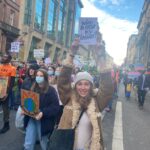




Amelia Temple
Global Communications Manager
Other reports
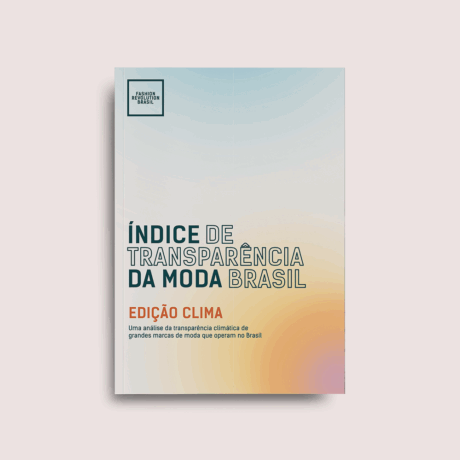
Índice de Transparência da Moda Brasil: edição clima
Uma análise da transparência climática de 60 grandes marcas de moda que operam no Brasil.
READ NOWLOOKING FOR THE FASHION TRANSPARENCY INDEX?
Explore the Fashion Transparency Index archive for past editions.
VISIT THE ARCHIVE
